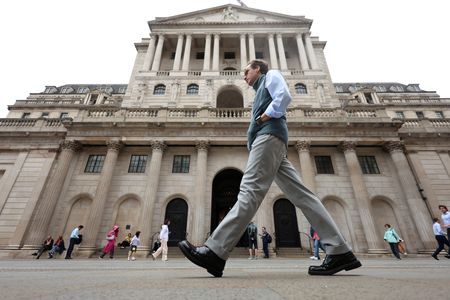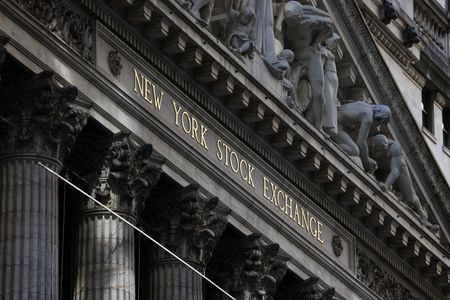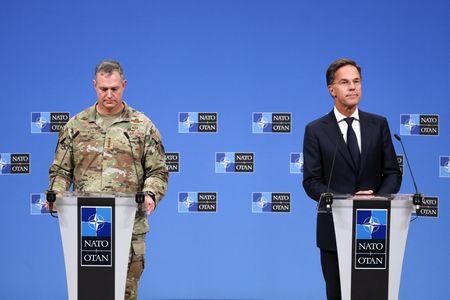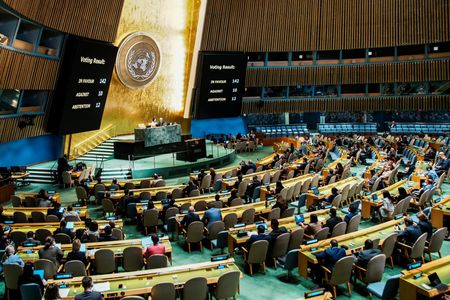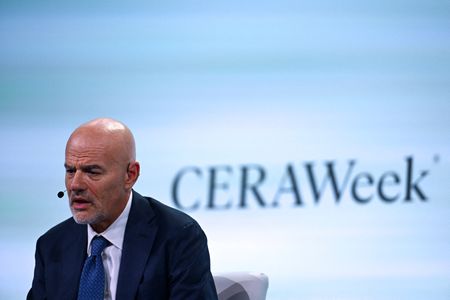By Anant Chandak and Shaloo Shrivastava
BENGALURU (Reuters) – The Bank of England will keep its key policy rate on hold on September 18 as inflation is creeping up, but it will cut once next quarter and again early next year, according to a majority of economists in a Reuters poll.
However, a growing minority of economists say the central bank is done with cutting this year.
After peaking at more than 11% nearly three years ago, inflation briefly returned to the central bank’s 2% target last year but has since risen to nearly double that. With cost-of-living pressures unlikely to let up any time soon, BoE Governor Andrew Bailey said recently there was less certainty about the speed of rate cuts.
Inflation is expected to touch 4% in September, according to central bank projections and not return to target until mid-2027.
All 67 economists in the September 8-11 poll expected the BoE to keep Bank Rate on hold at 4.00% on September 18, while a strong majority (42) pencilled in a quarter-point cut next quarter. Three economists forecast 50 basis points of cuts in Q4.
However, more than 30% or 22 of 67 now see Bank Rate unchanged for the rest of the year, compared with 15% in August.
“We’re still in the camp for a cut in November… Next week’s inflation data is going to be very, very important—not for the November meeting itself, but for setting the tone of next week’s decision and perhaps any language tweaks that they have there, whether they want to suggest the pace of cuts is slowing or not,” said James Rossiter, head of global macro strategy at TD Securities.
“If we get a little bit of a softening in inflation and continued labour-market softness, they’ve got everything they need to cut in November. You get a couple of upside inflation surprises, as the labour-market data improves or wage growth reaccelerates, then I think the case for skipping November builds.”
Labour and inflation data for August are scheduled to be released on September 16 and 17, respectively. According to the latest official data, average weekly earnings excluding bonuses grew 5% in the three months to June and inflation was at 3.8% in July.
Inflation was expected to average 3.8% this quarter and 3.6% next, staying elevated at 3.4% for the year and 2.5% in 2026. It won’t return to the central bank’s target until 2027, the poll found.
“With inflation running at double the Bank’s target, the optics are simply too ugly to justify cutting rates and there are real risks that…inflation expectations will start to drift up,” said Victoria Clarke, UK chief economist at Santander CIB, which changed its forecast from 50 bps more cuts previously to saying the Bank was done with the current cycle.
“The UK has been the G7 outperformer this year, albeit thanks to government spending, whilst private demand has been relatively subdued. There are no guarantees this strong G7 performer story will continue into 2026. But the squeeze on household real incomes from sticky inflation will nevertheless keep private-sector demand under pressure next year, as will restrictive interest rates.”
Britain’s economy was expected to post quarter-on-quarter growth of 0.2-0.4% through 2026 and average 1.3% this year and 1.2% next, slower than 1.4% last year.
The BoE has also started reducing the size of its balance sheet after increasing its stockpile of government bond holdings to 875 billion pounds ($1.2 trillion) following the global financial crisis and during the pandemic to support the economy. Since 2022, it has reduced its bond holdings to 558 billion pounds.
Asked how much the BoE will vote to reduce its bond holdings during October 2025-September 2026, the median forecast from 12 respondents showed 67.5 billion pounds. Forecasts ranged from 50 to 100 billion pounds.
(Other stories from the Reuters global economic poll)
($1 = 0.7376 pounds)
(Reporting by Anant Chandak and Shaloo Shrivastava; Polling by Indradip Ghosh and Reshma Ann Samuel; Editing by Hugh Lawson)

